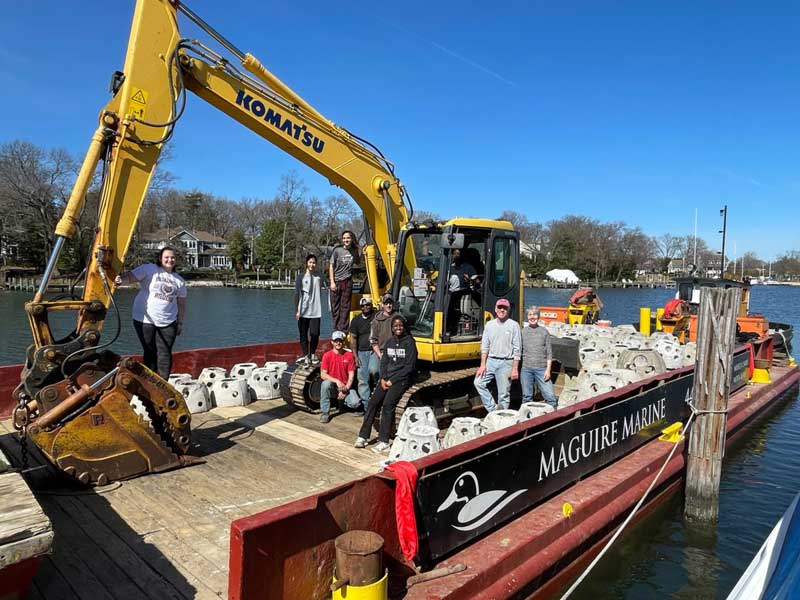Friday, March 17 was another great day for Chesapeake marine habitats after approximately 175 oyster reef balls made by area residents, Eagle Scouts, and students participating in Coastal Conservation Association Maryland’s Living Reef Action Campaign (LRAC) were placed on an existing reef site in the Magothy River, a Chesapeake Bay tributary north of Annapolis.

The Living Reef Action Campaign (LRAC) is Coastal Conservation Association’s flagship habitat and education program that engages students and communities throughout the Chesapeake Bay. Since 2014, LRAC has engaged thousands of students and community members across 15 counties in Maryland and Virginia in hands-on, educational experiences that improve the health of the Bay and its rivers while inspiring stewardship of our marine resources.
Reef balls help restore the Chesapeake’s marine habitats, improve water quality, and benefit recreational fishing. The three-dimensional structures resemble small igloos and were built by Cape Saint Claire community residents, Carroll County (MD) 4th graders, Eagle Scout candidates, and Broadneck High School students participating in LRAC. Volunteers with the Annapolis Busch Library also contributed time and energy to the project.
“This reef ball deployment is the culmination of nearly two years of hard work,” said David Sikorski, executive director of CCA Maryland. "Partners from throughout the region have come together to support this project that enhances the Magothy River and connects many Marylanders to the grassroots habitat restoration efforts that are a major focus of CCA’s work in the Chesapeake region.”
Since the passing of 14-year-old Broadneck resident Noah Anderson in 2019, the Dobbin’s Island Reef Site has been affectionately known as Noah’s Reef because of his deep love for being on the water with his family and Cape St. Claire, the waterfront community in which he lived. The reef site was originally about 50-foot by 50-foot when it was first loaded with reef balls in 2003. Since then, the reef site has expanded to measure 400-foot by 800-foot and is managed under a multi-year permit held by the Magothy River Association, which ensures that CCA Maryland has the flexibility necessary to continue to work with area students to build more reef balls that can be added to the reef. Maguire Marine Construction and Cypress Marine provided logistical expertise, the barge and other equipment necessary to deploy the reef balls on site in a safe and effective manner.
“Oyster reef balls provide excellent fish habitat and will provide an excellent return on our investment and effort," said Paul Spadaro, president of the Magothy River Association. “This is a win, win, win. A win for CCA’s LRAC program, a win for MRA efforts to restore oyster and fish habitat, and a win for recreational fishermen in the upper Bay.”
Added Mike Maguire of Maguire Marine Construction in Pasadena, “The Magothy River holds tremendous memories for me. It’s where I grew up, developed my passion for the Chesapeake Bay and working on the water. I want my children to have a chance to build similar memories. It’s amazing to be part of such a meaningful restoration project.”
Stacy Roth, the Environmental Literacy Signature Coordinator at Broadneck High School in Anne Arundel County, is a strong supporter of LRAC “because it increases the students' understanding of local environmental issues, while positively engaging them in the solution. The opportunity for students to work with strong community partners, form connections and develop career skills while practicing environmental stewardship makes LRAC the total package.”
“LRAC originated within our local school system in 2014, so we’re excited to see it grow throughout the Chesapeake region,” said Bryan Shumaker, STEM Coordinator with Carroll County (MD) Public Schools. “Students from elementary, middle, and high schools have taken part in LRAC and it provides an incredible student action component for a Meaningful Watershed Educational Experience (MWEE), a part of the Chesapeake Bay Agreement.”
LRAC provides resources for grassroots-driven projects that achieve these key objectives:
- Habitat Creation and Restoration
- Educating Coastal Communities on the Value of Conservation
- Advancing the Science of Habitat Restoration Through Monitoring
- Fostering Habitat Stewardship